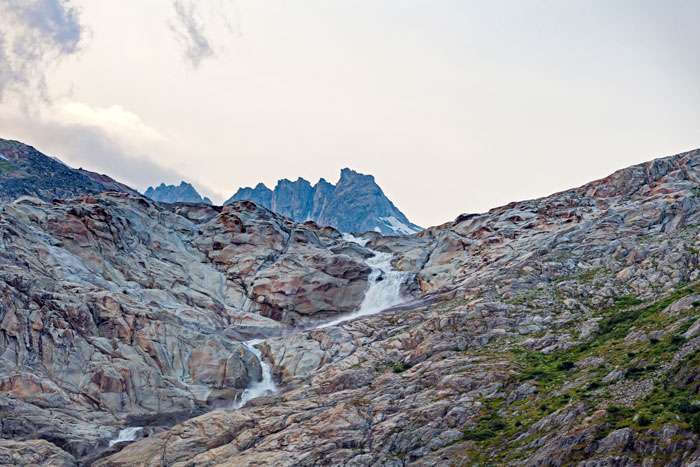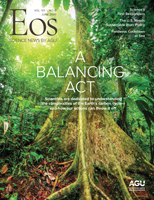Sample a stream that runs through the Amazon, the Congo basin, or Canada’s Northern Cordillera, and you’re likely to measure a large amount of carbon dioxide (CO2) dissolved in the water. That carbon mostly comes from plants, animals, and microbes that decompose in the water or return their carbon to the surrounding soil.
Mountain streams, however, start their journeys at high altitudes, which lack the carbon-rich soil of their lowland cousins. They haven’t been widely studied, and the few measurements that exist suggest that their water is carbon poor. Because of that, it’s been assumed that mountain streams don’t contribute all that much to the combined CO2 emission from river networks.
However, new research recently published in Nature Communications suggests that altogether, mountain streams likely emit more than half as much CO2 as the oceans absorb annually and emit more CO2 per square meter than tropical and boreal streams.
“Mountain streams may represent 10%–30% of the total flux from streams and rivers. They represent just 5% of the surface area of streams and rivers,” said lead researcher Åsa Horgby, a hydrogeologist at École Polytechnique Fédérale de Lausanne (EPFL) in Switzerland. In terms of global carbon flux, “they are overrepresented, but it’s really hard to estimate how much because we just don’t have enough data.”
Turbulence Releases Carbon Dioxide
Coauthor Tom Battin, who heads the Stream Biofilm and Ecosystem Research Laboratory at EPFL, said that their seeming unimportance to the carbon cycle and geographic inaccessibility have made mountain streams “aqua incognita” for carbon emission studies.
Recent research found that turbulent streams, like those flowing down mountainsides, exchange gas with the air more quickly than placid streams do, something that hadn’t been accounted for in global models of rivers’ CO2 flux.
“If you have a Coca Cola bottle and you shake it, for example, you get a higher flux. And this is what’s happening in mountain streams.”
“If you have a higher concentration [of CO2] in water than in the atmosphere, you have an outgoing flux. And then the opposite” for an ingoing flux, Horgby explained. “If you shake the water more, like if you have a Coca Cola bottle and you shake it, for example, you get a higher flux. And this is what’s happening in mountain streams.”
Prompted by that discovery, Horgby’s team wanted to reevaluate mountain streams’ contributions to the global carbon cycle. The researchers gathered CO2 concentration and elevation measurements for mountain streams around the world to calculate the amount of CO2 exchanged with the atmosphere.
“Our CO2 model is building on 323 measurements, which is not a lot on a global scale,” Horgby said, but in situ carbon data simply don’t exist for most mountain streams. Too, mountain streams across the globe are very different from each other, so it wouldn’t be accurate to use an average carbon flux measurement to represent unmeasured streams.

Instead, the researchers used the available data to develop new models that relate CO2’s rate of air exchange with more readily measured stream properties like temperature, width, and flow speed. Measurements from 12 high-altitude monitoring stations in the Swiss Alps validated those formulas, which the team then used to calculate the CO2 flux one by one for more than 23,000 mountain streams in Switzerland and nearly 2 million across the globe.
“Rather than aggregating CO2 and gas exchange for some area,” said Robert Hall, a stream and river ecologist at the University of Montana in Polson, “the authors predicted a CO2 concentration and a gas exchange rate for each stream, multiplied these, and then summed them up by region. This approach should provide higher accuracy and allow estimation of uncertainty.” Hall was not involved with this research.
An Ocean’s Worth of Carbon
The researchers found that on average, a Swiss mountain stream will emit 3.5 kilograms of carbon per year for every square meter of stream area. That flux per area is unexpectedly high, the team said. Even though mountain streams account for roughly 5% of the global area covered by rivers and streams, their combined CO2 outflux—about 1.7 gigatons of carbon per year—is about the same as that of tropical streams and “substantially higher” than that of boreal streams and rivers, which cover much more area.

“When you take all of the inland waters—streams, rivers, lakes, etc.—we think that they emit as much CO2 per year as the oceans globally absorb per year,” Battin said. “The fluxes, although in different directions, are the same order of magnitude. For the ocean, it’s something like 2.5 gigatons of carbon per year. For the inland waters it’s between 2–3 gigatons.”
“Even in high-elevation ecosystems where terrestrial productivity may be low, there is a large transfer of carbon to aquatic systems.”
Most of that emission has been assumed to come from rivers running through carbon-rich areas. This new estimate “implies that even in high-elevation ecosystems where terrestrial productivity may be low, there is a large transfer of carbon to aquatic systems,” said David Butman. Butman studies the biogeochemistry of watersheds at the University of Washington in Seattle and was not involved with this research.
The team found that by area, most mountain streams were net sources of CO2. Just over 10%, however, were unexpected carbon sinks, including streams running through the interior of the Tibetan Plateau and the Altiplano region in the Andes. This study wasn’t designed to find out why that might be, Horgby said, but will hopefully spark future research.
This study “presents a snapshot in time and space,” Butman said. “This is our best guess at an annual contribution. However, we know that streamflow is driven by daily changes in precipitation, melting,” and other factors. What’s more, our understanding of gas exchange with turbulent water is still developing, Hall and Butman each pointed out, so these estimates of carbon flux may evolve along with our understanding of the underlying physical process. Battin said that data collection from the Swiss stations is ongoing and will help pin down the carbon flux more accurately.
Where Does the Carbon Come From?
“High-mountain streams are typically above the tree line,” Battin said, “so there’s not much organic carbon up there. Their catchments are devoid of vegetation, and their soils are poorly developed.”
So where does the carbon come from? The researchers suggested that the carbon might come primarily from the surrounding rocks and soil rather than from carbon dissolved directly into the stream water.
“These authors convincingly showed that the CO2 from Swiss streams was some combination of soil respiration and weathering,” Hall said. “Thus, the CO2 was produced outside the stream and emitted to the atmosphere by the stream.”
“Many of us claim,” Battin said, “that streams and rivers and lakes emit lots of CO2 into the atmosphere and therefore they are major players in the global carbon cycle. Now we understand more and more that especially for the high-mountain streams, most of that CO2 is from the catchment, not from the stream itself.”
—Kimberly M. S. Cartier (@AstroKimCartier), Staff Writer
Citation:
Cartier, K. M. S. (2020), Mountain streams exhale more than their share of CO2, Eos, 101, https://doi.org/10.1029/2020EO142549. Published on 20 April 2020.
Text © 2020. AGU. CC BY-NC-ND 3.0
Except where otherwise noted, images are subject to copyright. Any reuse without express permission from the copyright owner is prohibited.
Text © 2020. AGU. CC BY-NC-ND 3.0
Except where otherwise noted, images are subject to copyright. Any reuse without express permission from the copyright owner is prohibited.


